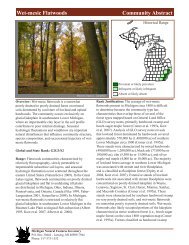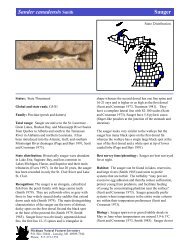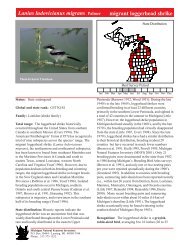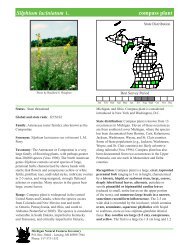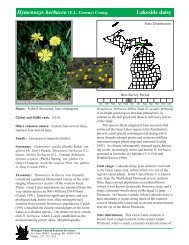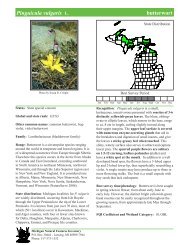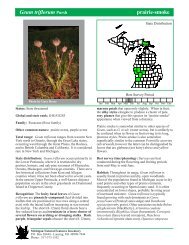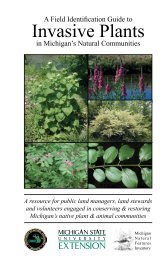Poa alpina - Michigan Natural Features Inventory - Michigan State ...
Poa alpina - Michigan Natural Features Inventory - Michigan State ...
Poa alpina - Michigan Natural Features Inventory - Michigan State ...
You also want an ePaper? Increase the reach of your titles
YUMPU automatically turns print PDFs into web optimized ePapers that Google loves.
cobwebby tuft at the lemma base, P. annua and P.<br />
autumnalis have five distinct lemma nerves, while P.<br />
compressa and P. canbyi have narrow inflorescences and<br />
lack long hairs between the keel and margin of the<br />
lemma.<br />
Best survey time/phenology: Most of the observations<br />
and collections of this species have occurred from early<br />
July through August, and flowering plants have been<br />
observed as early as mid-June. The optimal survey<br />
period for this species is thus estimated to be from mid-<br />
June through early September.<br />
FQI Coefficient and Wetland Category: 10, FACU<br />
Habitat: On Isle Royale’s shores, <strong>Poa</strong> <strong>alpina</strong> grows in<br />
basaltic rock crevices and along other wave-splashed,<br />
rocky shores where its associates include such species as<br />
Campanula rotundifolia (harebell), Potentilla tridentata<br />
(three-toothed cinquefoil), Trisetum spicatum (downy<br />
oatgrass), Euthamia graminifolia (grass-leaved<br />
goldenrod), Sagina nodosa (pearlwort), Polygonum<br />
viviparum (alpine bistort), Castilleja septentrionalis<br />
(pale Indian paintbrush), and Achillea millefolium<br />
(yarrow). On Passage Island it inhabits a disturbance<br />
opening and is concentrated along a footpath, growing in<br />
dense sod with Antennaria neglecta (pussytoes),<br />
Plantago major (common plantain), Fragaria<br />
virginiana (wild strawberry), and other native and<br />
adventive species. Although it thrives along rocky<br />
shores, alpine bluegrass may also occur along paths and<br />
elsewhere in interior areas under aspen and other<br />
overstory trees and or under shrubs such as Shepherdia<br />
canadensis (buffaloberry) and Physocarpus opulifolius<br />
(ninebark) or in open bearberry (Arctostaphylos uvaursi)<br />
– juniper (Juniperus spp.) heaths. Along the<br />
shoreline of Drummond Island, this species occurs on<br />
limestone in moist seepage areas with Trisetum spicatum<br />
and Carex scirpoidea (bulrush sedge). Elsewhere in its<br />
range it inhabits mostly calcareous subalpine and arctic<br />
habitats including alpine meadows, and also often occurs<br />
in disturbed ground (Flora of North America 2007).<br />
Biology: Alpine bluegrass is a tufted, low-growing<br />
perennial species. P. <strong>alpina</strong> subsp. vivipara, which is<br />
most common throughout northern and central Europe,<br />
is well known for its ability to reproduce asexually<br />
through the development of bulbiferous spikelets,<br />
producing spikelets that are either completely bulbiferous<br />
or those that are partly bulbiferous and partly flowering<br />
<strong>Michigan</strong> <strong>Natural</strong> <strong>Features</strong> <strong>Inventory</strong><br />
P.O. Box 30444 - Lansing, MI 48909-7944<br />
Phone: 517-373-1552<br />
alpine bluegrass, Page 2<br />
(Flora of North America 2007). Producing vegetative<br />
bulbs or plantlets in place of seeds is a reproductive<br />
approach demonstrated by certain arctic/alpine grass<br />
species, and can be considered a conservation strategy<br />
for retaining genetic traits developed by stress tolerators<br />
in low nutrient habitats (Pierce et al. 2003). Pierce as<br />
well as Baxter and Farrar (1999) and Baxter et al. (1997)<br />
found through detailed experiments that <strong>Poa</strong> <strong>alpina</strong> var.<br />
vivipara (and possibly var. <strong>alpina</strong>) actually lost<br />
photosynthetic capacity through long-term growth under<br />
elevated CO 2 conditions. Their findings indicate that<br />
global climate change may adversely affect alpine<br />
bluegrass, although the research thus far appears to have<br />
focused primarily on one subspecies.<br />
Conservation/management: The majority of the<br />
<strong>Michigan</strong> stations for this species are contained within<br />
Isle Royale National Park, where there are few threats,<br />
although protection of these sites from excessive foot<br />
traffic and human alteration of adjacent inland<br />
communities is advised. Searches of the Keweenaw<br />
Peninsula shoreline should be continued to relocate<br />
historical mainland localities. Inventories are also<br />
warranted elsewhere throughout the Upper Peninsula to<br />
identify additional new populations in calcareous bedrock<br />
shoreline areas, as this somewhat obscure grass species<br />
may be overlooked.<br />
Comments: <strong>Poa</strong> ×gaspensis Fernald is a rare hybrid<br />
between P. <strong>alpina</strong> and P. pratensis subsp. alpigena<br />
(Lindm.) Hiitonen, known only from the coastal<br />
mountains of the Gaspé Peninsula in Quebec, Canada<br />
(Flora of North American 2007). <strong>Poa</strong> <strong>alpina</strong> ecotypes<br />
and their origin as glacial relics were examined in an<br />
extensive paper by Turesson (1927).<br />
Research needs: In addition to inventories, the<br />
conservation and management of this species would<br />
benefit from basic life history studies, including research<br />
on population structure and genetic diversity.<br />
Related abstracts: Volcanic bedrock lakeshore, smallflowered<br />
wood rush, alpine bistort, pearlwort, encrusted<br />
saxifrage, prickly saxifrage, rayless mountain ragwort,<br />
squashberry



